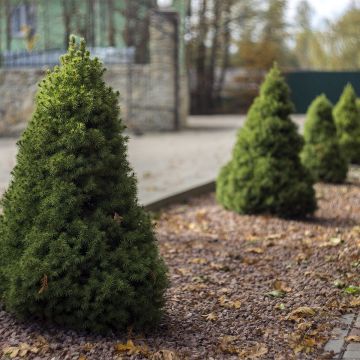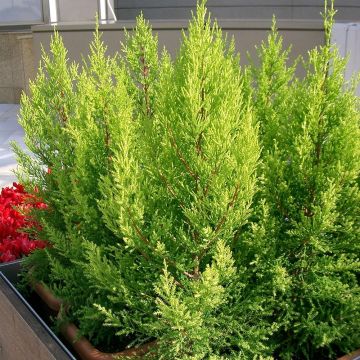

Taxus baccata - Bowl Shape Yew
Taxus baccata - Bowl Shape Yew
Taxus baccata
Yew, Common Yew, English Yew, European Yew
Special offer!
Receive a €20 voucher for any order over €90 (excluding delivery costs, credit notes, and plastic-free options)!
1- Add your favorite plants to your cart.
2- Once you have reached €90, confirm your order (you can even choose the delivery date!).
3- As soon as your order is shipped, you will receive an email containing your voucher code, valid for 3 months (90 days).
Your voucher is unique and can only be used once, for any order with a minimum value of €20, excluding delivery costs.
Can be combined with other current offers, non-divisible and non-refundable.
Home or relay delivery (depending on size and destination)
Schedule delivery date,
and select date in basket
This plant carries a 24 months recovery warranty
More information
We guarantee the quality of our plants for a full growing cycle, and will replace at our expense any plant that fails to recover under normal climatic and planting conditions.
Would this plant suit my garden?
Set up your Plantfit profile →
Description
The Taxus baccata is our common yew tree, well known for its dark green evergreen foliage, small orange to red fruits, and highly sought-after hard wood. Slow-growing, it is one of the top species for topiary art, of which this ball shape is a good example. Its fine and dense foliage, tolerant to pruning, allows for the creation of distinctive scenes in the garden. Planted in the ground, accompanied by other topiaries, or in a square wooden or metal container, to provide permanent decoration on a terrace or on either side of an entrance, this conifer will bring character to your environment. Easy to grow, it adapts to many living conditions.
Very present in the oldest gardens and parks in Europe, Taxus baccata sometimes watches over us for hundreds of years. Its longevity is indeed remarkable and can reach several centuries. The species, which has become rare in the wild, is native to Europe, Asia Minor, and North Africa. In France, it is still found in the plains of Brittany, Normandy, and the Vosges, in low and medium mountains, in the south and in Corsica. Some populations also survive in the limestone massifs of Provence, on the northern slopes of the Sainte Baume and the Sainte Victoire near Aix-en-Provence. Some individuals growing in the Verdon Gorge are said to be over a thousand years old. Impressive specimens can also be admired in old gardens or cemeteries, near churches for symbolic reasons (considered as a link between heaven and earth), but also to prevent herds from consuming them. The needles, bark, and fruits are indeed toxic to humans and animals, except for birds that consume the berries and discard the seeds. The common yew is a conifer of the Taxaceae family, with only 15 to 20 species.
When shaped into a sphere, the foliage of this yew tree will be particularly highlighted. Its branchlets are covered with flattened, pointed needles, but very soft to the touch. Their color, a shiny dark green, is lighter on the underside. The leaves are small (2-3 mm (1in) x 2-3 cm (1in)) and persist on the plant for several years before renewing. It is a dioecious species: individuals bear either male or female flowers. Thus, the red berries appear after discreet flowering (but appreciated by bees, as the species is nectar-producing) only on female plants. Be careful, while the aril (the brightly colored fleshy part) is not toxic, the seeds are highly toxic!
If this specimen is grown in a container, regular watering will be necessary as it will not have access to soil moisture reserves. Its maintenance requires two annual prunings, in April and on the regrowth in September. It is ideal to use sharp shears rather than hedge trimmers. The cuts will be cleaner, without the risk of damaging the foliage, and above all, it is easier to take one's time to perfect the work!
This yew topiary will be most valuable in a highly structured garden, with geometric shapes. French gardens immediately come to mind, but a contemporary space will also benefit from its presence, as well as Mediterranean gardens. In the latter, there will be plenty of choices for complementary plants to create graphic scenes by playing with shapes, colors, and even scents. The Pittosporum tobira 'Nanum' with its slow growth in a natural cushion shape and its beautiful bright green leaves or the woody germander with its aromatic grayish foliage will be excellent neighbors in a flowerbed.
In small spaces that do not allow for entire beds of topiaries, this yew tree can be planted alongside plants with complementary appearances. For example, a beautiful golden creeping barberry will bring light and a graceful form that will create surprise at the base of this dark green ball. A black elderberry 'Black Tower' will play the same role with a welcome contrast of form and color.
Report an error about the product description
Plant habit
Flowering
Foliage
Safety measures
Botanical data
Taxus
baccata
Taxaceae
Yew, Common Yew, English Yew, European Yew
Cultivar or hybrid
ingestion
Cette plante est toxique si elle est ingérée volontairement ou involontairement.
Ne la plantez pas là où de jeunes enfants peuvent évoluer, et lavez-vous les mains après l'avoir manipulée.
Pensez à conserver l'étiquette de la plante, à la photographier ou à noter son nom, afin de faciliter le travail des professionnels de santé.
Davantage d'informations sur https://plantes-risque.info
Other Taxus - Yew
View all →Planting and care
The common Yew, even in ball form, is not demanding: it thrives in full sun or partial shade and even tolerates shade. It can be planted in ordinary soil, slightly chalky or acidic, preferably moist but above all well-drained. It is best to plant it in autumn or spring, watering well during planting. Monitor and water during the first two years to ensure the bush establishes well, and you can also mulch the soil to maintain some moisture in summer. Afterwards, only water during dry periods, as the Yew is quite tolerant once well rooted.
Planting period
Intended location
Care
This item has not been reviewed yet - be the first to leave a review about it.
Similar products
Haven't found what you were looking for?
Hardiness is the lowest winter temperature a plant can endure without suffering serious damage or even dying. However, hardiness is affected by location (a sheltered area, such as a patio), protection (winter cover) and soil type (hardiness is improved by well-drained soil).

Photo Sharing Terms & Conditions
In order to encourage gardeners to interact and share their experiences, Promesse de fleurs offers various media enabling content to be uploaded onto its Site - in particular via the ‘Photo sharing’ module.
The User agrees to refrain from:
- Posting any content that is illegal, prejudicial, insulting, racist, inciteful to hatred, revisionist, contrary to public decency, that infringes on privacy or on the privacy rights of third parties, in particular the publicity rights of persons and goods, intellectual property rights, or the right to privacy.
- Submitting content on behalf of a third party;
- Impersonate the identity of a third party and/or publish any personal information about a third party;
In general, the User undertakes to refrain from any unethical behaviour.
All Content (in particular text, comments, files, images, photos, videos, creative works, etc.), which may be subject to property or intellectual property rights, image or other private rights, shall remain the property of the User, subject to the limited rights granted by the terms of the licence granted by Promesse de fleurs as stated below. Users are at liberty to publish or not to publish such Content on the Site, notably via the ‘Photo Sharing’ facility, and accept that this Content shall be made public and freely accessible, notably on the Internet.
Users further acknowledge, undertake to have ,and guarantee that they hold all necessary rights and permissions to publish such material on the Site, in particular with regard to the legislation in force pertaining to any privacy, property, intellectual property, image, or contractual rights, or rights of any other nature. By publishing such Content on the Site, Users acknowledge accepting full liability as publishers of the Content within the meaning of the law, and grant Promesse de fleurs, free of charge, an inclusive, worldwide licence for the said Content for the entire duration of its publication, including all reproduction, representation, up/downloading, displaying, performing, transmission, and storage rights.
Users also grant permission for their name to be linked to the Content and accept that this link may not always be made available.
By engaging in posting material, Users consent to their Content becoming automatically accessible on the Internet, in particular on other sites and/or blogs and/or web pages of the Promesse de fleurs site, including in particular social pages and the Promesse de fleurs catalogue.
Users may secure the removal of entrusted content free of charge by issuing a simple request via our contact form.
The flowering period indicated on our website applies to countries and regions located in USDA zone 8 (France, the United Kingdom, Ireland, the Netherlands, etc.)
It will vary according to where you live:
- In zones 9 to 10 (Italy, Spain, Greece, etc.), flowering will occur about 2 to 4 weeks earlier.
- In zones 6 to 7 (Germany, Poland, Slovenia, and lower mountainous regions), flowering will be delayed by 2 to 3 weeks.
- In zone 5 (Central Europe, Scandinavia), blooming will be delayed by 3 to 5 weeks.
In temperate climates, pruning of spring-flowering shrubs (forsythia, spireas, etc.) should be done just after flowering.
Pruning of summer-flowering shrubs (Indian Lilac, Perovskia, etc.) can be done in winter or spring.
In cold regions as well as with frost-sensitive plants, avoid pruning too early when severe frosts may still occur.
The planting period indicated on our website applies to countries and regions located in USDA zone 8 (France, United Kingdom, Ireland, Netherlands).
It will vary according to where you live:
- In Mediterranean zones (Marseille, Madrid, Milan, etc.), autumn and winter are the best planting periods.
- In continental zones (Strasbourg, Munich, Vienna, etc.), delay planting by 2 to 3 weeks in spring and bring it forward by 2 to 4 weeks in autumn.
- In mountainous regions (the Alps, Pyrenees, Carpathians, etc.), it is best to plant in late spring (May-June) or late summer (August-September).
The harvesting period indicated on our website applies to countries and regions in USDA zone 8 (France, England, Ireland, the Netherlands).
In colder areas (Scandinavia, Poland, Austria...) fruit and vegetable harvests are likely to be delayed by 3-4 weeks.
In warmer areas (Italy, Spain, Greece, etc.), harvesting will probably take place earlier, depending on weather conditions.
The sowing periods indicated on our website apply to countries and regions within USDA Zone 8 (France, UK, Ireland, Netherlands).
In colder areas (Scandinavia, Poland, Austria...), delay any outdoor sowing by 3-4 weeks, or sow under glass.
In warmer climes (Italy, Spain, Greece, etc.), bring outdoor sowing forward by a few weeks.


















































